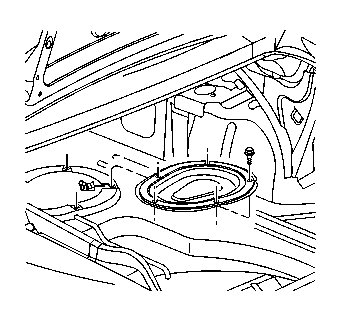Removal Procedure
Caution: Fuel Vapors can collect while servicing fuel system parts in enclosed
areas such as a trunk. To reduce the risk of fire and increased exposure to
vapors:
• Use forced air ventilation such as a fan set outside
of the trunk. • Plug or cap any fuel system openings in order to reduce fuel vapor
formation. • Clean up any spilled fuel immediately. • Avoid sparks and any source of ignition. • Use signs to alert others in the work area that fuel system work
is in process.
- Relieve the fuel system pressure. Refer to Plastic Collar Quick Connect Fitting Service .
- Drain the fuel tank. Refer to Fuel Tank Draining .
- Remove the rear compartment trim panel. Refer to Rear Compartment Trim Panel Replacement in Body Rear End.
- Remove the fuel sender access panel bolts.
- Remove the fuel sender access panel.
- Disconnect the fuel sender quick-connect fittings. Refer to Plastic Collar Quick Connect Fitting Service .
- Disconnect the fuel sender electrical connector.
- Disconnect the fuel tank pressure sensor electrical connector.
- Remove the fuel sender retaining ring using the fuel sender lock nut wrench.
- Remove the fuel sender assembly.
- Clean the fuel sender sealing surfaces.
- Inspect the fuel sender sealing surfaces.


Notice: In order to prevent damage, cover the fuel pipe fittings with a shop towel before disconnecting the fuel pipes or removal of the fuel sender retaining ring, in order to catch any fuel that may leak out. Place the towel in an approved container when procedure is completed.
Important: The modular fuel sender assembly will spring-up when the locking ring is removed.
Notice: Do Not handle the fuel sender assembly by the fuel pipes. The amount of leverage generated by handling the fuel pipes could damage the joints.
Important: When removing the fuel sender assembly from the fuel tank, the reservoir bucket on the fuel sender is full of fuel. The fuel sender must be tipped slightly during removal in order to avoid damage to the float. Place any remaining fuel into an approved container once the fuel sender is removed from the fuel tank.
Installation Procedure
- Position the new fuel sender seal on the fuel tank.
- Install the fuel sender assembly and the fuel sender lock ring using the fuel sender lock nut wrench.
- Connect the quick-connect fittings at the fuel sender. Refer to Plastic Collar Quick Connect Fitting Service .
- Connect the fuel sender electrical connector.
- Connect the fuel tank pressure sensor electrical connector.
- Add fuel to the fuel tank.
- Install the fuel tank filler pipe cap.
- Connect the negative battery cable. Refer to Battery Negative Cable Disconnection and Connection in Engine Electrical.
- Perform the following procedure in order to inspect for leaks:
- Install the fuel sender access panel.
- Install the fuel sender access panel bolts.
- Install the rear compartment trim panel. Refer to Rear Compartment Trim Panel Replacement in Body Rear End.
- Install the fuel injector sight shield. Refer to Fuel Injector Sight Shield Replacement in Engine Mechanical.

Important: Care should be taken not to fold over or twist the fuel pump strainer when installing the fuel sender assembly, as this will restrict fuel flow. Also, assure that the fuel pump strainer does not block full travel of the float arm.
Important: Always replace the fuel sender seal when reinstalling the fuel sender.
| 9.1. | Turn ON the ignition, with the engine OFF for 2 seconds. |
| 9.2. | Turn OFF the ignition for 10 seconds. |
| 9.3. | Turn ON the ignition, with the engine OFF. |
| 9.4. | Inspect for fuel leaks. |

Notice: Refer to Fastener Notice in the Preface section.
Tighten
Tighten the fuel sender access panel bolts to 2 N·m
(18 lb in).
